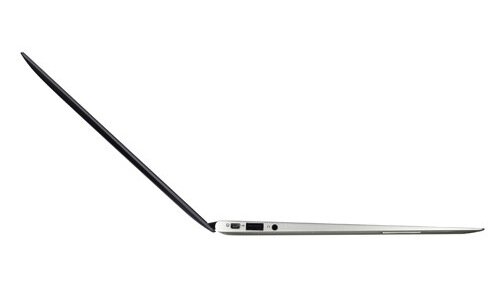Sleek, slim and stylish ultraportable PCs have been available for years, but they cost a pretty penny and were stuck with low-voltage mobile processors that sacrificed performance for the sake of power consumption. The advent of Intel 2nd-generation Core processors has changed all that though, and the new ASUS ZENBOOK shows just what is possible when world-class industrial design is combined with cutting-edge mobile technology.
The ZENBOOK is the first notebook PC from ASUS to conform to the new Intel ‘Ultrabook’ standard. Despite packing dual-core mobile processors that deliver blistering performance, Ultrabooks are designed to be extremely thin and offer very long battery life with rapid start-up times. If the new ZENBOOK is anything to go by, they’re designed to look absolutely stunning, too.
Gorgeous good looks
The ZENBOOK UX31E is a 13.3” Ultrabook, available with either an Intel Core i5 (1.7GHz) or Core i7 (1.8GHz) processor running the 64-bit edition of Windows 7. Slip the ZENBOOK from its stylish matte black box (which is wholly made from cardboard and wholly recyclable, by the way) and the first thing to strike you is how fantastic it looks.
Every visible surface is made from aluminium — finished in standard silver on the bottom half of the case and ‘amethyst grey’ on the top. The lid also has what ASUS describes as a ‘spun metal’ finish, which consists of countless fine concentric circles etched into the surface of the metal, with a silver ASUS logo right in the centre.
The all-aluminium construction makes the ZENBOOK feel extremely robust, which is extremely important for a laptop that’s so thin. At its front edge, where the two halves of the case meet, the ZENBOOK is a mere 3mm thick and only 17mm at the thickest point of its rounded wedge shape. Subtract 3mm or so for the lid from that measurement and you have to wonder how ASUS has managed to cram everything in so little space — even the power supply is barely bigger than a mains plug.
Ports a plenty
The ZENBOOK may not be much thicker than a mobile phone, but it still carries a useful selection of ports. The left side of the case has one USB 3.0 port for a neat bit of future-proofing, plus an SD card slot and 3.5mm headphone socket; the right side has a USB 2.0 port, and both mini VGA and micro HDMI ports for output to external displays.
There’s no Ethernet socket, but there is a USB network adapter in the ZENBOOK box, along with standard VGA adapter for the mini VGA port. Both are stashed in a neat little pouch made from the same brown weave material as the ZENBOOK slipcase that ASUS also supplies.
Quality in, quality out
The ZENBOOK lid sits on a wide hinge that, although wonderfully wobble-free, lifts smoothly with just a single finger. The hinge also incorporates stereo speakers powered that are surprisingly loud given their size, with a rich sound quality that puts most high-end desktop replacement laptops to shame. This can be attributed to the ASUS SonicMaster technology that drives them — a combination sophisticated audio processing and high-quality audio components, developed in conjunction with the B&O ICEpower team.
ASUS has long since standardised on isolated keyboards for its notebooks, but the ZENBOOK gets an extra premium touch — all the keys are also made from aluminium. The black legends stand out clearly against the large silver keys and the keys also contrast nicely against their dark very background. The full-size layout with widely spaced keys is very comfortable to type on, and the generously proportioned (105 x 70mm) multi-touch trackpad can be easily reached with a thumb, you don’t have to stop typing when you need to point and click.
Comfortable input is only one aspect of any computer, of course, but the ZENBOOK is excellently equipped for output, too. The 13.3” screen with 1600 x 900 resolution has a 16:9 ratio, and its glossy finish gives rich colours and intense blacks. It’s bright too, thanks to the LED backlight, and with a wide viewing angle that makes the ZENBOOK well-suited to informal presentation situations — or just sharing a movie with friends.
High-performance portability
The Intel Core i7 2677M processor inside the ZENBOOK UX31E reviewed here is dual-core and also supports Hyper-Threading, so it effectively has four cores for dealing with all kinds of demanding applications. The processor runs at 1.8GHz when all cores are firing, but Intel’s Turbo Boost 2.0 technology can automatically raise the clock speed of one core up to 2.9GHz for applications that aren’t multi-core aware, while dropping the speed of the rest to maintain power-efficient performance.
Combined with 4GB of DDR RAM, a 128GB SSD (in this particular model) and integrated Intel HD Graphics 3000, the result is a seriously quick computer For a notebook though, that usually equates to one seriously short battery life, but the Intel’s processor power-saving technology, together with ASUS’ legendary Super Hybrid Engine II, can stretch mains-free use to up to five hours, with up to two weeks of standby time (ASUS even supplies a handy Desktop widget that shows how long the battery will last). Best of all, however, is the ZENBOOK’s ability to wake from sleep mode in just two seconds, so there’s no hanging around when you want to start working.
The last word
So, how much would you expect to pay for a 13.3” ultra-slim ultraportable that packs this much performance? £2,000? £1,500? Well, here’s the other astonishing thing about the ZENBOOK UX31E is that ASUS has set a starting price of just £999, which is quite the deal when you consider how much such slim and sexy ultraportables would set you back in the past.







James Kidder